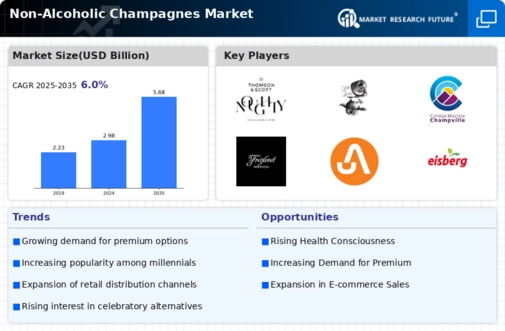Social Acceptance
Social acceptance of non-alcoholic beverages is a significant driver for the Global Non-Alcoholic Champagnes Market Industry. As societal norms evolve, non-alcoholic options are increasingly embraced in various social settings, including parties and celebrations. This shift is supported by the rise of alcohol-free events and gatherings, where non-alcoholic champagne serves as a sophisticated alternative. The growing visibility of these products in restaurants and bars further enhances their appeal. This trend suggests that the market could see substantial growth, potentially reaching 5.68 USD Billion by 2035, as more consumers opt for non-alcoholic choices in social contexts.
Health Consciousness
The increasing awareness of health and wellness among consumers drives the Global Non-Alcoholic Champagnes Market Industry. As individuals prioritize healthier lifestyles, the demand for non-alcoholic beverages rises. This trend is particularly evident among millennials and Generation Z, who are more inclined to choose non-alcoholic options. The market is projected to reach 2.98 USD Billion in 2024, reflecting a growing preference for beverages that offer celebratory experiences without the effects of alcohol. This shift indicates a potential for sustained growth in the sector, as consumers seek alternatives that align with their health goals.
Sustainability Trends
Sustainability trends are increasingly influencing consumer choices within the Global Non-Alcoholic Champagnes Market Industry. As environmental concerns rise, consumers are gravitating towards brands that prioritize sustainable practices, such as organic farming and eco-friendly packaging. This shift is evident in the growing number of non-alcoholic champagne producers adopting sustainable methods, which not only appeal to eco-conscious consumers but also enhance brand loyalty. The emphasis on sustainability may drive market growth, as consumers are likely to support brands that align with their values. This trend suggests a promising trajectory for the industry as it adapts to changing consumer preferences.
Diverse Flavor Profiles
The introduction of diverse flavor profiles in non-alcoholic champagnes contributes to the expansion of the Global Non-Alcoholic Champagnes Market Industry. Manufacturers are innovating to create unique blends that appeal to a broader audience, incorporating fruits, herbs, and spices to enhance taste. This innovation not only attracts traditional champagne consumers but also engages those who may not have previously considered non-alcoholic options. The growing variety of flavors may lead to increased market penetration, as consumers seek new experiences. This trend aligns with the projected CAGR of 6.04% for 2025-2035, indicating a robust future for the industry.
Market Growth Projections
The Global Non-Alcoholic Champagnes Market Industry is projected to experience substantial growth over the coming years. With a market value of 2.98 USD Billion in 2024, the industry is expected to expand significantly, reaching 5.68 USD Billion by 2035. This growth trajectory reflects a compound annual growth rate (CAGR) of 6.04% from 2025 to 2035. Such projections indicate a robust demand for non-alcoholic champagne, driven by changing consumer preferences, health trends, and increased social acceptance. The market's evolution suggests a dynamic landscape, where innovation and consumer engagement will play pivotal roles in shaping its future.
Innovative Marketing Strategies
Innovative marketing strategies play a crucial role in shaping the Global Non-Alcoholic Champagnes Market Industry. Brands are leveraging social media, influencer partnerships, and experiential marketing to engage consumers and promote non-alcoholic options. These strategies aim to create a lifestyle around non-alcoholic beverages, positioning them as desirable choices for celebrations and everyday enjoyment. By effectively communicating the benefits and experiences associated with non-alcoholic champagnes, brands can attract a wider audience. This approach is likely to contribute to the anticipated growth of the market, as it aligns with evolving consumer behaviors and preferences.












